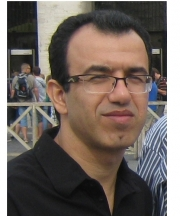Selective Adsorption of Mercury (II) From Aqueous Solution Using Functionalized Nanochitosan by Carbon Disulfide
Mercury (Hg) is one of the water pollutants and its removal from the aqueous environment is important. The major goal of this study was to remove the Hg (II) from aqueous solution by synthesizing a modified nanochitosan with carbon disulfide functional groups. Nanochitosan was synthesized using citric acid as an environmentally friendly crosslinking agent, and then it was modified with a carbon disulfide functional group. The characteristics of synthesized nanocomposite were studied by using proton nuclear magnetic resonance (1HNMR), transmission electron microscopy (TEM), scanning electron microscopy (SEM), and Fourier transform infrared spectroscopy (FTIR). Batch adsorption experiments of Hg (II) in metal ion solution were conducted under different conditions such as pH, temperature, contact time, initial concentration of metal ion and adsorbent dosage. The adsorption process was conducted to investigate the compatibility of data with isotherms models (Freundlich and Langmuir), kinetics (pseudo-first-and second-order rate equations) and adsorption thermodynamics in a batch system. Reusability of adsorbent using 0.5 mol/L HCl and also effect of ion interferences were investigated for selectivity of adsorbent. Obtained results from this study confirmed the successful synthesis and functionalizing process of the nano-adsorbent. The optimal values were reported as pH=7, adsorbent dosage of 0.2 g/L, initial concentration of 30 mg/g Hg (II) and contact time of 120 min. Sorption of mercury agreed well with the Langmuir isotherm model, confirming a monolayer adsorption. The maximum equilibrium adsorption capacity for mercury ions was 303.03 mg/g. The results of kinetic studies showed that the sorption process followed the second order model. The results of thermodynamics showed that the adsorption process was exothermic and spontaneous. Possibility of recovery of adsorbent was investigated up to five cycles and desorption percentage of mercury ions was more than 95%.Also, the results of ion interferences effect in mixed solution showed that the percentage of mercury removal with the functionalization of nanochitosan by carbon disulfide increased up to 88% and the synthesized adsorbent has a high selectivity for mercury ions. Based on the high adsorption efficiency obtained for mercury ions in the mixed solution, the synthesized adsorbent can be at promising approach in treatment of real wastewaters with low concentrations of mercury ions and other interfering ions in order to obtain an admissible effluent standard. The results showed that the synthesized nanoadsorbent is an efficient low cost adsorbent for mercury removal from wastewater due to its high adsorption capacity , as well as its reusability and selectivity for mercury.
- حق عضویت دریافتی صرف حمایت از نشریات عضو و نگهداری، تکمیل و توسعه مگیران میشود.
- پرداخت حق اشتراک و دانلود مقالات اجازه بازنشر آن در سایر رسانههای چاپی و دیجیتال را به کاربر نمیدهد.



